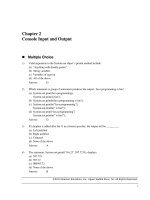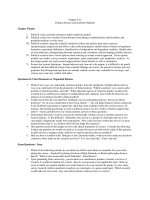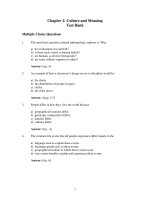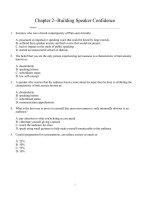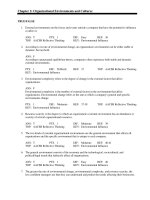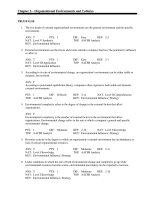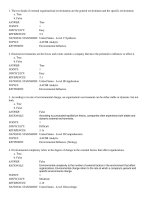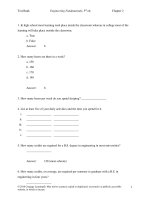Corporate financial management 5th edition glen arnold test bank
Bạn đang xem bản rút gọn của tài liệu. Xem và tải ngay bản đầy đủ của tài liệu tại đây (334.08 KB, 7 trang )
MULTIPLE CHOICE. Choose the one alternative that best completes the statement or answers the question.
1) What is meant by the term 'Net Present Value'?
1) _______
A) The future value of cash flows after netting out the initial cash flow.
B) The present value of future cash flows after netting out the initial cash flow.
C) The gross sum of the final cash flow and the present value of future cash flows.
D) The gross sum of the initial cash flow and the future value of future cash flows.
2) What is the fundamental question that must be answered during an investment appraisal?
A) What is the time value of the money invested?
B) Is the proposed course of action profitable?
C) What are the cash flow implications?
D) Is the proposed course of action wealth creating?
2) _______
3) What is meant by the term 'Investor’s Opportunity Cost'?
A) The loss in the value of the funds invested resulting from inflation
B) The sacrifice of the return available on the best forgone alternative with equivalent risk
C) The discounted cash costs of the investment
D) The cost involved in offering the investor the opportunity to invest
3) _______
4) What is meant by the term 'Internal Rate of Return'?
A) The rate of return that equates the present value of future cash flows with the outlay
B) The rate of return that equates the future value of cash flows with the outlay
C) The rate of return that equates the present value of future cash flows with opportunity cost
D) The rate of return that equates the outlay with the predicted overall profit
4) _______
5) What name is given to the rate of exchange between certain future consumption and certain
current consumption, when there is no inflation and no risk?
A) Internal rate of return
B) Net rate of return
C) Pure rate of interest
D) Inflation proofing
5) _______
6) You are asked to calculate the time value of money that requires compensation for the delay in
the receipt of cash. Which three of the following factors would you consider?
A) Inflation
B) Net present value
C) Pure time value
D) Risk
6) _______
7) Suppose certain providers of finance are to be compensated for their rate of time preference by a
discount rate of 3 per cent, at a time when inflation is anticipated to be 4 per cent. What overall
return will they require on risk-free investments?
A) 1.1%
B) 7.1%
C) 1%
D) 12%
7) _______
8) How are present values of cash flows obtained in a Net Present Value calculation?
A) By discounting at the opportunity cost of capital
B) By discounting at the impatience to consume rate of return
C) By allowing for the internal rate of return
D) By adding a term to allow for future risk
8) _______
9) Which of the following best describes what investors in shares seek compensation for?
A) The risk-free rate of return plus a risk premium plus a premium for inflation
B) The loss of interest on a building society account plus the dividend yield on shares
C) Sacrifice of immediate use of cash otherwise available for consumption, inflation and risk
D) Inflation and risk only
9) _______
10) What term is used for the discount rate which, when applied to the cash flows of a project,
results in a zero net present value?
A) Net future value
B) Internal rate of return
C) Absolute rate of return
D) Multiple internal rate
10) ______
11) What discount rate is used when calculating net present value?
A) The bank rate
B) The internal rate of return
C) The discounted cash flow rate
D) The opportunity cost of capital
11) ______
12) An investor anticipates that inflation will be 4 per cent over the next year, and expects a return of
3 per cent for the pure time value of money. What risk premium will compensate the investor?
A) 7%
B) 7.1%
C) 1%
D) 12%
12) ______
13) What is the future value of a deposit of £200 in an account paying interest at 5 per cent over a
four year period?
A) £234.10
B) £243.10
C) £240.00
D) £220.00
13) ______
14) How much should an investor invest now to receive £250 in 3 years time if the interest rate is 5
per cent?
A) £225.45
B) £291.59
C) £200.00
D) £215.96
14) ______
15) What term is used for the present value of future cash flows after netting out the initial cash
flow?
A) Net present value
B) Gross present value
C) Net future value
D) Gross future value
15) ______
16) What term is used for the yield forgone on the best investment alternative?
A) Internal rate of return
B) Discounted Net Value
C) Net Loss of Value
D) Opportunity cost of capital
16) ______
17) An investor anticipates that inflation will be 5 per cent over the next year, and expects a return of
2 per cent for the pure time value of money. She also expects a risk premium of 4 per cent per
year. What overall return is required in the first year?
A) 11.1%
B) 12.1%
C) 11%
D) 14%
17) ______
18) A company has a cash flow in year 3 of +£1800. Assuming that the time value of money is 10 per
cent, what is the discounted cash flow at time zero?
A) £1803.16
B) £1910.00
C) £1657.02
D) £1352.57
18) ______
19) A project has an initial cost of of £20m, and after one year there is cash flow of £5.5m. If the
opportunity cost of capital is 10 per cent, what is the NPV?
A) -£15m
B) £15.95m
C) £25m
D) -£15.95m
19) ______
20) Which three of the following are disadvantages of using the IRR method rather than the NPV
method of project appraisal?
A) If the cash flows are non-conventional there may be more than one IRR.
B) IRR has an implicit reinvestment assumption at the IRR itself which is not reasonable.
C) IRR does not take into account the time value of money.
D) IRR ranks in terms of percentage returns whereas NPV ranks in terms of amounts of
money.
20) ______
21) A project has an initial cost of £30m and the opportunity cost of capital is 10 per cent per year.
There is an expected cash flow after year 1 of £8.8m. What is the NPV?
A) +£39.68m
B) -£24.2m
C) -£22m
D) -£20.32m
21) ______
22) The opportunity cost of capital must be the minimum required return from any project. Which of
the following options best explains why that must be so?
A) An external investment must offer the firm more than they can achieve by saving the
funds.
B) An internal investment must offer investors less than they can achieve by saving the funds.
C) An internal investment must offer investors more than they can achieve by investing the
funds for themselves.
D) Brokers must be able to invest the funds for themselves externally.
22) ______
23) In discounted cash flow analysis, which of the following is a bad decision rule?
A) If IRR ≥ opportunity cost of capital then reject
B) If IRR < opportunity cost of capital then reject
C) If NPV ≥ 0 then accept
D) If NPV < 0 then reject
23) ______
24) Which of the following statements best explains how NPV can help decision makers?
A) A negative NPV shows that a project is shareholder wealth enhancing.
B) A positive NPV shows that a project is risk free and shareholder wealth enhancing.
C) A positive NPV shows that a project is shareholder wealth enhancing.
D) A negative NPV shows that a project is shareholder wealth enhancing but of high risk.
24) ______
25) What do the two terms r and k represent in the IRR rule k ≤ r Accept?
A) k = discounted cash flow; r = net present value
B) k = internal rate of return; r = opportunity cost of capital
C) k = net present value; r = discounted cash flow
D) k = opportunity cost of capital; r = internal rate of return
25) ______
26) Which three of the following would you need to know when calculating the net present value of
a five year project?
A) The initial cash flow
B) The opportunity cost of capital
C) The cash flow in year 1
D) The real rate of return
26) ______
27) Calculations of the IRR based on a value of r = 5% give a NPV value of £234,000. Trying the
effect of increasing and decreasing r gives -£876,000 when r = 10% and £456,000 when r = 2%.
Which of the following values of r is most likely to be correct?
A) 1.7%
B) 9.7%
C) 6.2%
D) 2.5%
27) ______
28) What term is used for the present value of the future cash flows after netting out the initial cash
flow.
A) Net present value
B) Real value
C) Discounted present value
D) Net discounted value
28) ______
29) IRR calculations are biased because they assume that intra-project cash flows can be invested at a
particular rate of return. What is that particular rate?
A) IRR
B) The real rate of return
C) Bank rate
D) Discounted bank rate
29) ______
30) What is meant by the term 'annuity'?
30) ______
A)
B)
C)
D)
Payments to a pension fund
Bonds that pay a variable rate of interest
The annual total of a number of payments
A series of payments or receipts of equal amounts
31) A firm has funds and needs to decide what to do with them. What are the two most likely
options that they would consider?
A) Hand money back to shareholders
B) Invite shareholders to make further investment in the firm
C) Issue bonds
D) Invest with the firm
31) ______
32) The values of NPV for four projects have been calculated as follows: Project A = £11m; Project B
= 0; Project C = -£5m; Project D = -£12m. Which of the projects would you suggest should be
adopted?
A) Projects B, C and D
B) Projects A and B
C) Only Project A
D) Project C and D
32) ______
33) In an assessment of the internal rate of return (r) of two projects the following results are
obtained: r is 8% for Project A and 12% for Project B. What decisions should be followed if the
opportunity cost of capital is 10%?
A) Accept both projects
B) Reject both projects
C) Reject A and accept B
D) Accept A and reject B
33) ______
34) When interpolating two calculated values of IRR, which of the options will give the most
accurate result?
A) Expand the vertical scale of the chart
B) Maximise the gap between discount
rates
C) Reduce the vertical scale of the chart
D) Minimise the gap between discount
rates
34) ______
35) Which three of the following statements correspond to limitations of the IRR method, when
compared with the NPV approach?
A) IRR does not give percentage results
B) The possibility of multiple solutions
C) Limits on the accuracy of rankings
D) Confusion between investing-type and financing-type decisions
35) ______
36) Which of the two approaches (IRR and NPV) takes account of the time value of money?
A) Only IRR
B) Only NPV
C) Both IRR and NPV
D) Neither IRR nor NPV
36) ______
37) Which of the following statements is true?
A) Additivity of IRRs is always possible.
B) Additivity is never possible for NPVs or IRRs.
C) NPVs are additive.
D) Additivity of NPVs is always possible.
37) ______
38) Which of the following correctly summarises one of the IRR investment rules?
A) k > r Accept
B) k ≤ r Reject
C) k ≤ r Accept
D) k < r Accept
38) ______
39) Which three of the following statements are true?
39) ______
A)
B)
C)
D)
NPV is appropriate for financing-type decisions.
In financing-type decisions the use of the IRR criterion may be misleading.
NPV is appropriate for investing-type decisions.
Investing type decisions may result in misinterpretation of IRR results.
40) Which of the following options describes IRR and NPV ranking in situations of mutual
exclusivity?
A) They are never the same.
B) They may be in the opposite order.
C) They are always in the opposite order.
D) They are always the same.
40) ______
41) Which of the following statements is correct?
A) NPV and IRR both measure in absolute amounts of money.
B) NPV measures in absolute amounts of money. IRR is a percentage measure.
C) IRR measures in absolute amounts of money. NPV is a percentage measure.
D) NPV and IRR are both percentage measures.
41) ______
42) Which of the following outcomes can result when IRR is used in appraising projects with
unconventional cash flows?
A) Inaccurate ranking positions
B) Mutual exclusivity
C) High apparent opportunity costs
D) Multiple solutions
42) ______
43) What will be the value of an investment of present value £200 at compound interest of 10 per
cent after 2 years?
A) £242
B) £158
C) £180
D) £220
43) ______
44) An investor wants to invest at 9 per cent compound interest and receive a payment of £181.30
after 5 years. What initial investment is required?
A) £117.83
B) £142.21
C) £185.36
D) £125.68
44) ______
45) What is the present value of an indefinite annual payment of £20, where the discount rate is 10
per cent?
A) £200
B) £220
C) £181.82
D) £22
45) ______
46) An investor is comparing an account with Twelvers Bank that pays 12 per cent annually with
one at Sixers Bank that pays 6 per cent semi-annually. What advice would you give?
A) Invest with both and pay the interest from Sixers into the Twelvers account
B) Invest with Twelvers to get a better return
C) Returns from the two banks will be identical
D) Invest with Sixers to get a better return
46) ______
47) What is meant by a contract in perpetuity?
A) It is a contract on which interest payments are reviewed at annual intervals.
B) The contract lasts for the lifetime of the property or equipment.
C) The rate of interest gradually decreases until payments can be written off.
D) It is a contract that runs indefinitely, with no end to the series of payments.
47) ______
48) A lender charges a monthly rate of 2 per cent. What is the equivalent annual percentage rate?
A) 24%
B) 28.62%
C) 26.82%
D) 12.68%
48) ______
49) A regular payment of £200 per year is to be made over 5 years. If the interest rate is 12 per cent,
what is the present value of the annuity?
A) £921.00
B) £721.00
C) £1012.00
D) £940.00
49) ______
50) A lender lends at an annual rate of 15%. What is the equivalent monthly rate?
A) 1.17%
B) 1.07%
C) 1.71%
D) 1.51%
50) ______
1)
2)
3)
4)
5)
6)
7)
8)
9)
10)
11)
12)
13)
14)
15)
16)
17)
18)
19)
20)
21)
22)
23)
24)
25)
26)
27)
28)
29)
30)
31)
32)
33)
34)
35)
36)
37)
38)
39)
40)
41)
42)
43)
44)
45)
46)
47)
48)
49)
50)
B
D
B
A
C
A, C, D
B
A
C
B
D
B
B
D
A
D
A
D
A
A, B, D
C
C
A
C
D
A, B, C
C
A
A
D
A, D
B
C
D
B, C, D
C
D
C
A, B, C
B
B
D
A
A
A
D
D
C
B
A
